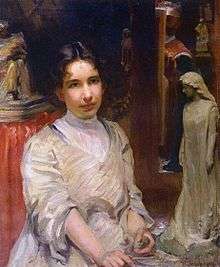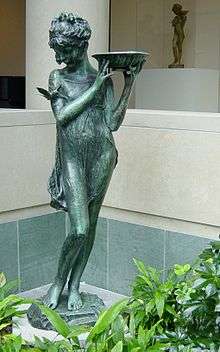Bessie Potter Vonnoh
| Bessie Potter Vonnoh | |
|---|---|
 Portrait of Bessie Potter Vonnoh, by Robert Vonnoh, 1907 | |
| Born |
Bessie Potter August 17, 1872 St. Louis, Missouri, U.S. |
| Died |
March 8, 1955 (aged 82) New York City, New York, U.S. |
| Nationality | American |
| Known for | Sculpture |
| Spouse(s) |
Robert Vonnoh (1899–1933, until his death) Edward L. Keyes (1948–1949, until his death) |
| Elected |
National Academy of Design (1921) American Academy of Arts and Letters (1931) |
Bessie Potter Vonnoh (August 17, 1872 – March 8, 1955) was an American sculptor best known for her small bronzes, mostly of domestic scenes, and for her garden fountains.
Early years

Bessie Potter was born in St Louis, Missouri, the only child of Ohio natives Alexander and Mary McKenney Potter. Her father died in 1874, in an accident, at age 38.[1]:p. 7 By 1877, she and her mother had joined members of her mother's family in Chicago.[1]:p. 9
In school she enjoyed clay-modeling class and decided at an early age that she wanted to be a sculptor.[2] In 1886, at age 14, she enrolled in classes at the Art Institute of Chicago.[3] She was able to afford the tuition only because a local sculptor, Lorado Taft, hired her to work as a studio assistant, on Saturdays. From 1890 to 1891 she studied with Taft at the Art Institute, as she completed its sculptor courses.[1]:p. 11, 15
Early works
Vonnoh became one of the so-called "White Rabbits", women artists who assisted Taft on the sculpture program for the Horticultural Building at the 1893 World's Columbian Exposition in Chicago. She also produced an independent commission, the Personification of Art, for the Illinois State Building of the exposition.
In 1895, she traveled to Europe, and met Auguste Rodin. Her best-known statuette, Young Mother (1896), used fellow "White Rabbit" Margaret Daisy Gerow (Mody) Proctor, wife of sculptor Alexander Phimister Proctor, and their infant son as models. In 1898, she received the commission for a bust of General Samuel W. Crawford for the Smith Memorial Arch in Philadelphia.[4]
In 1899 she married impressionist painter Robert Vonnoh, at his home in Rockland Lake, New York,[5] and honeymooned in Paris. At the 1900 Exposition Universelle, she was awarded a Bronze Medal for Young Mother and for another statuette, Dancing Girl.
She exhibited at both the 1901 Pan-American Exposition in Buffalo, New York, and at the 1904 Louisiana Purchase Exposition in St Louis, Missouri, where she was awarded a Gold Medal for a group of ten works.
Middle years

In 1933, her husband died at age 75.[6] In 1937, she completed her best-known large-scale work, the Frances Hodgson Burnett Memorial in Central Park.[7] She produced little after that.
In March 1903, the New York Times noted that the Vonnohs were two of a dozen painters and sculptors who had gotten together to create a building specifically for their studios, at 27 West Sixty-Seventh Street in Manhattan.[8] In mid-1903, the Vonnohs began summering in Old Lyme, Connecticut, and became long-time members of its Old Lyme Art Colony.
In December 1912, the New York Times, writing about her works at the New York Academy of Art, called her figurines "lovely", of a "charming style", and said "we must applaud once more her skillful harmonizing of detail in the contemporary costume, her selection of the most distinguished line for emphasis."[9] In 1915, Vonnoh exhibited in the Armory Show. In 1921, she was elected an academician of the National Academy of Design. She was elected to the American Academy of Arts and Letters in 1931.[10]
Later years

In 1948, she remarried, to Dr. Edward L. Keyes, Jr., a widower,[11] who died only nine months later.[12] She died in New York City in 1955, at age 82.[13] Vonnoh is buried alongside her first husband, Robert Vonnoh (1858 – 1933) in the Duck River Cemetery in Old Lyme, Connecticut.
References
- 1 2 3 Julie Aronson (2008). Bessie Potter Vonnoh: Sculptor of Women. Ohio University Press. ISBN 978-0-8214-1800-0.
- ↑ "Bessie Potter Vonnoh papers, circa 1860-1991, bulk 1890-1955". Archives of American Art. Retrieved July 29, 2011.
- ↑ Benjamin Genocchio (November 21, 2008). "In Her Hands, Naturalism Won Out". New York Times.
- ↑ Crawford bust
- ↑ "A Marriage of Artists; Miss Bessie Potter Quietly Wedded to R.W. Vonnoh". New York Times. September 21, 1899.
- ↑ "Robert Vonnoh, Noted Hartford Artist, Dies". The Hartford Courant. December 29, 1933.
- ↑ Burnett Memorial
- ↑ "A New Hive of Artists; Studios Built by a Dozen Painters to Suit Themselves -- Practical Side of the Sixty-seventh St. Building". New York Times. March 27, 1903.
- ↑ "Art at Home and Abroad; From the Academic to the Modern Is the Range Shown in Exhibition of Sculpture at the Academy". New York Times. December 22, 1912.
- ↑ "Deceased Members". American Academy of Arts and Letters. Archived from the original on July 26, 2011. Retrieved July 30, 2011.
- ↑ "Mrs. Bessie P. Vonnoh a Bride". New York Times. June 27, 1948.
- ↑ "Edward Loughborough Keyes, Jr., Papers: Part 2 (special collections)". Georgetown University. Retrieved 2011-07-30.
- ↑ "Bessie P. Yonnoh, Sculptor, was 82; Widow of Dr. Edward Keyes Is Dead--Her Works Won Many Medals in Shows". New York Times. March 9, 1955.
- Baigell, Matthew (1979) "Vonnoh, Bessie Potter" Dictionary of American Art Harper & Row, Publishers, New York;
- Bowman, John S. (ed.) (1995) "Vonnoh, Bessie (Onahotema) Potter" The Cambridge Dictionary of American Biography Cambridge University Press, Cambridge, England;
- Falk, Peter Hastings (1985) "Vonnoh, Bessie Potter" Who Was Who in American Art: 1898-1947 Sound View Press, Madison, CT;
- Garraty, John A. and Carnes, Mark C. (eds.) (1999) "Vonnoh, Bessie Onahotema Potter" American National Biography Oxford University Press, New York;
- Heller, Jules and Heller, Nancy G. (1995) "Vonnoh, Bessie Potter" North American Women Artists of the Twentieth Century: A biographical dictionary Garland Publishing, New York
- Tolles, Thayer. “Bessie Potter Vonnoh (1872–1955).” In Heilbrunn Timeline of Art History. New York: The Metropolitan Museum of Art, 2000–. (April 2012)
External links
| Wikimedia Commons has media related to Bessie Potter Vonnoh. |